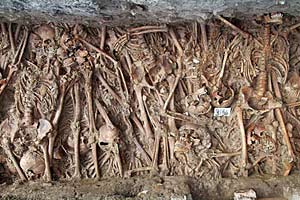The Great Plague of London happened between 1665 and 1666.
Background: The Time of Plague

Plague was a major disease in Europe for hundreds of years (‘The Black Death’ plague alone killed between 75 million and 200 million people across Europe between 1348 and 1350 – 30-60% of Europe’s population). London itself had been hit by plague 3 times already that century: in 1603, 1625, and 1636.
It is believed this particular plague came from the Netherlands: 50 000 people had died in Amsterdam of plague in 1663-1664, and London and Amsterdam were major trade points.
Plagues would continue in Europe until the end of the 18th century. It was not until 1894 that the cause of plague was discovered.
Plague Arrives in London

London was not a clean city in the 17th century: many poor people lived in terrible conditions, and waste was often thrown into the streets.
The first deaths began to happen around April 1665. However, because many people did not report deaths, and often the cause of death was wrongly diagnosed, the reported numbers were strange: for example, whilst there were only 4 confirmed plague deaths, the city’s death rate rose by 100 people per week (from under 300 to nearly 400).
As the weather got warmer, more people began to realise what was happening. Efforts were made to quarantine St Giles – one of the first areas in London to have confirmed plague deaths – and many people left the city.
As the wealthy fled, including the king, poor people found it difficult to escape because they needed money and work. Nobody was allowed to leave unless they passed a health check, and soon the villages around London began to refuse Londoners even if they had a health certificate.

London Shuts Down
As nobody knew how plague was passed from one person to another, efforts to stop the disease failed. Factories were shut down to try to make the air cleaner. Many people suspected animals were a problem, and dogs and cats were killed; unfortunately this may have made the situation worse, as it allowed rats – the true carriers – to spread.
By the end of July, the plague was an epidemic: over 3000 people died in a week, with over 2000 confirmed as being plague victims. As London usually had about 300 people die per week, it is likely that many of the 1000 other deaths were also plague victims. By September, the numbers dying in and around London were up to 7000 a week.
London stopped being an operating city. Most businesses had closed, and the only transport were the carts taking away the dead bodies. Food was left in special areas for people in the city to pick up.
The body cart’s drivers’ shouts of ‘Bring out your dead’ became famous.
The plague also spread to other areas around the country. The village of Eyam is believed to have lost 75% – 80% of its population to plague.
The End

By February 1666 the plague numbers had decreased and people – including the King – returned. Others came to London thinking there was a way to make money as the city recovered.
In total, The Great Plague of London killed approximately 100 000 people in the capital (about 15% – 20% of the city’s population), and maybe 200 000 people in the whole country.
Just as the city was recovering, however, The Great Fire of London hit in September 1666, destroying much of the city centre. Some people think this helped stop the plague, but the plague was already nearly finished by the time of the fire.
There was a positive to come out of these two years of disaster: with the damage caused by the plague and the fire London could be rebuilt. New wider streets, better sewage systems, and cleaner buildings were constructed. The 1665-1666 plague was the last major one in the UK.